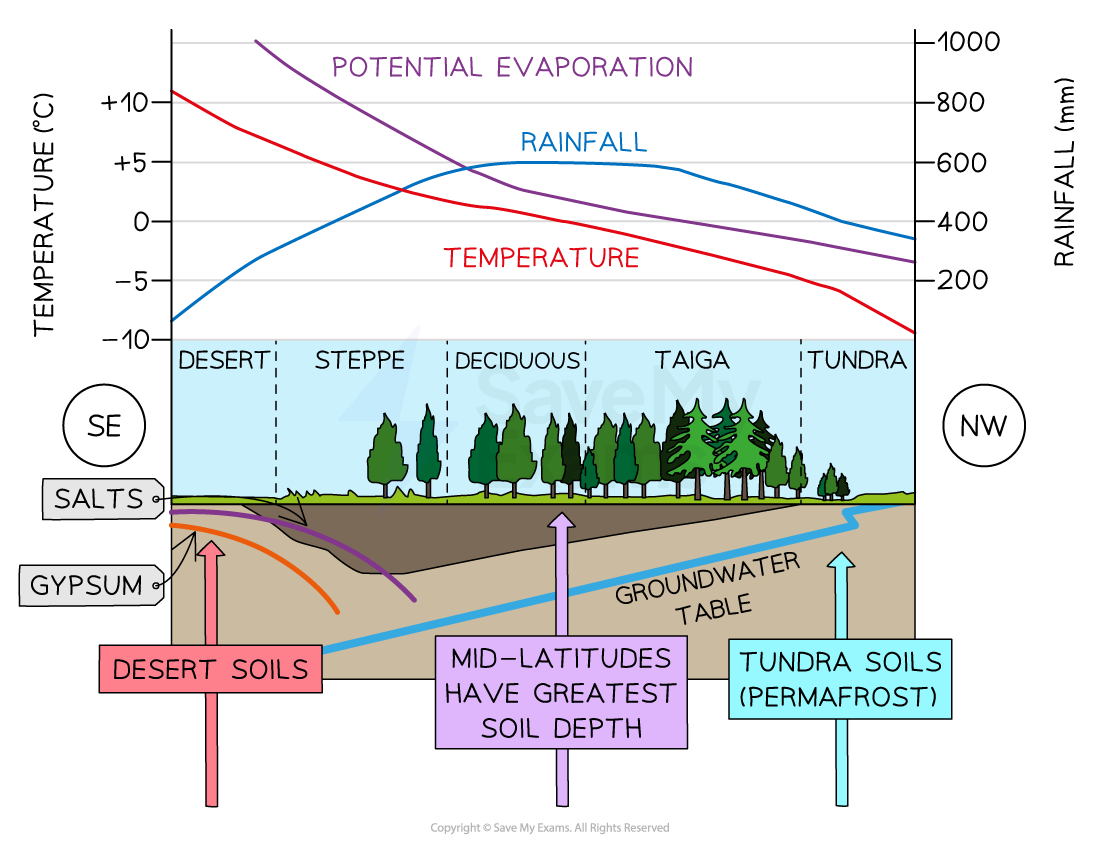Concept of the Biome
- A biome is a term for a large naturally occurring community of flora and fauna occupying a major habitat, usually at a continental scale
- There are different biomes, named after its dominant vegetation and based on the climate, soil, latitude, and altitude
- Each biome has its own distinct characteristics which are determined by its climate, this affects:
- Length of the growing season
- Temperature and precipitation levels, which in turn, impacts on the amount of plant growth
- Therefore, vegetation distribution is limited by its environment
- If any environmental factor changes, this will become a limiting factor in plant growth
- Limiting factors are also responsible for the geography of plant distribution
- E.g. cacti are only found in arid regions due to limited water supplies

Distribution of terrestrial biomes
Biome Distribution and Characteristics
| Biome | Location | Climate Characteristics | Other Characteristics |
| Tropical Rainforests |
Low latitudes within the tropics 23.5° north and south of the equator Found in South America, Asia and Africa |
Annual rainfall - 2000mm High temperatures 26-28°C Convectional rainfall |
Ideal conditions for plant growth High levels of biodiversity Distinct layers of vegetation |
| Tropical Monsoon Forest |
5-30° north and south of the equator Located in India, Central America and South-east Asia |
Rainfall between 700-2000mm Temperatures 30-45°C in summer and 15-30°C in winter Monsoon rainfall in the rainy season |
High levels of biodiversity Mahogany, teak, lianas, orchids Monkeys, Jaguars, snakes, frogs |
| Mediterranean |
Approximately 40-45° north of the equator Southern Europe and North Africa |
Hot dry summers, wet, mild winters Temperatures usually between 20-25°C. In Winter temperatures are around 10°C Rainfall averages 800mm |
Dense scrubland Vegetation includes herbs such as lavender and rosemary Trees include citrus and olives |
| Deciduous Forest |
Approximately 50° north of the equator Europe and North America |
Wet, mild winters and warm, drier summers Average temperature around 10°C with no extremes |
Deciduous trees which lose their leaves in winter due to the cooler temperatures - include oak, beech, ash Wide range of animals and plants Deer, rabbits, squirrels, bears |
| Coniferous Forest |
Approximately 60° north of the equator Northern Europe, Canada and Russia |
Cold winters and mild summers Winter temperatures can reach -40°C and summer temperatures 20°C |
Many trees are evergreen Include species such as spruce, pine Less biodiversity than temperate forests Bears, squirrels, foxes, wolves |
| Savanna (tropical) Grassland |
Between 15-30° north and south of the equator South America, Central Africa, Australia |
Distinct wet and dry seasons Temperatures vary between 15-35°C Annual rainfall 800-900mm |
Dominated by grasses Baobab and Acacia trees Savanna animals include giraffes, lions, zebras, elephants |
| Temperate Grassland |
Between 30-40° north and south of the equator Southern Africa, Russia, North America |
Hot summers 40°C, Cold winters -30°C Annual rainfall 250-750mm a year |
Dominated by grasses, very few trees Animals include bison, deer, snakes |
| Desert |
Approximately 20-30° north and south of the equator Africa, Australia, South and North America |
Hot daytime temperatures up to 50°C but average 25°C Night time temperatures below 0°C Precipitation below 250mm |
Low diversity Plants include yucca and cacti Animals include spiders, scorpions, camels |
| Polar/tundra |
Above 60° north and south of the equator Arctic, Antarctic, Northern Canada, Siberia |
Cold year round, brief cool summers in tundra areas Below 0° C for 6-10 months Precipitation often below 250mm |
Low biodiversity Short growing season Small grasses, lichens and mosses Arctic fox, polar bears, penguins, caribou |



